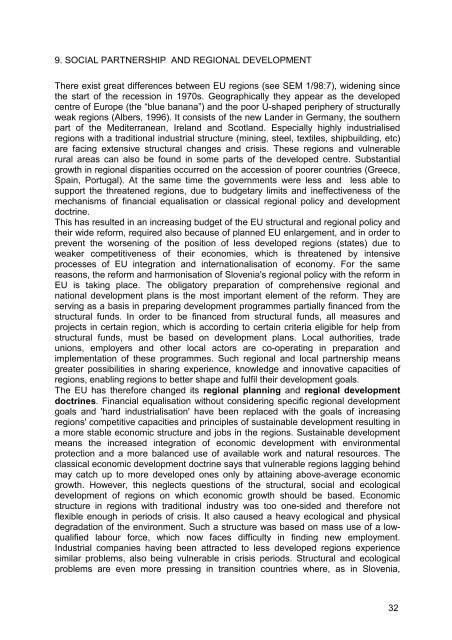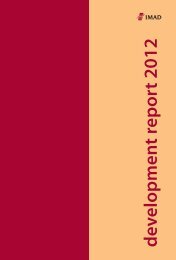The Development of New Industrial Relations in Slovenia - UMAR
The Development of New Industrial Relations in Slovenia - UMAR
The Development of New Industrial Relations in Slovenia - UMAR
You also want an ePaper? Increase the reach of your titles
YUMPU automatically turns print PDFs into web optimized ePapers that Google loves.
9. SOCIAL PARTNERSHIP AND REGIONAL DEVELOPMENT<br />
<strong>The</strong>re exist great differences between EU regions (see SEM 1/98:7), widen<strong>in</strong>g s<strong>in</strong>ce<br />
the start <strong>of</strong> the recession <strong>in</strong> 1970s. Geographically they appear as the developed<br />
centre <strong>of</strong> Europe (the “blue banana”) and the poor U-shaped periphery <strong>of</strong> structurally<br />
weak regions (Albers, 1996). It consists <strong>of</strong> the new Lander <strong>in</strong> Germany, the southern<br />
part <strong>of</strong> the Mediterranean, Ireland and Scotland. Especially highly <strong>in</strong>dustrialised<br />
regions with a traditional <strong>in</strong>dustrial structure (m<strong>in</strong><strong>in</strong>g, steel, textiles, shipbuild<strong>in</strong>g, etc)<br />
are fac<strong>in</strong>g extensive structural changes and crisis. <strong>The</strong>se regions and vulnerable<br />
rural areas can also be found <strong>in</strong> some parts <strong>of</strong> the developed centre. Substantial<br />
growth <strong>in</strong> regional disparities occurred on the accession <strong>of</strong> poorer countries (Greece,<br />
Spa<strong>in</strong>, Portugal). At the same time the governments were less and less able to<br />
support the threatened regions, due to budgetary limits and <strong>in</strong>effectiveness <strong>of</strong> the<br />
mechanisms <strong>of</strong> f<strong>in</strong>ancial equalisation or classical regional policy and development<br />
doctr<strong>in</strong>e.<br />
This has resulted <strong>in</strong> an <strong>in</strong>creas<strong>in</strong>g budget <strong>of</strong> the EU structural and regional policy and<br />
their wide reform, required also because <strong>of</strong> planned EU enlargement, and <strong>in</strong> order to<br />
prevent the worsen<strong>in</strong>g <strong>of</strong> the position <strong>of</strong> less developed regions (states) due to<br />
weaker competitiveness <strong>of</strong> their economies, which is threatened by <strong>in</strong>tensive<br />
processes <strong>of</strong> EU <strong>in</strong>tegration and <strong>in</strong>ternationalisation <strong>of</strong> economy. For the same<br />
reasons, the reform and harmonisation <strong>of</strong> <strong>Slovenia</strong>'s regional policy with the reform <strong>in</strong><br />
EU is tak<strong>in</strong>g place. <strong>The</strong> obligatory preparation <strong>of</strong> comprehensive regional and<br />
national development plans is the most important element <strong>of</strong> the reform. <strong>The</strong>y are<br />
serv<strong>in</strong>g as a basis <strong>in</strong> prepar<strong>in</strong>g development programmes partially f<strong>in</strong>anced from the<br />
structural funds. In order to be f<strong>in</strong>anced from structural funds, all measures and<br />
projects <strong>in</strong> certa<strong>in</strong> region, which is accord<strong>in</strong>g to certa<strong>in</strong> criteria eligible for help from<br />
structural funds, must be based on development plans. Local authorities, trade<br />
unions, employers and other local actors are co-operat<strong>in</strong>g <strong>in</strong> preparation and<br />
implementation <strong>of</strong> these programmes. Such regional and local partnership means<br />
greater possibilities <strong>in</strong> shar<strong>in</strong>g experience, knowledge and <strong>in</strong>novative capacities <strong>of</strong><br />
regions, enabl<strong>in</strong>g regions to better shape and fulfil their development goals.<br />
<strong>The</strong> EU has therefore changed its regional plann<strong>in</strong>g and regional development<br />
doctr<strong>in</strong>es. F<strong>in</strong>ancial equalisation without consider<strong>in</strong>g specific regional development<br />
goals and 'hard <strong>in</strong>dustrialisation' have been replaced with the goals <strong>of</strong> <strong>in</strong>creas<strong>in</strong>g<br />
regions' competitive capacities and pr<strong>in</strong>ciples <strong>of</strong> susta<strong>in</strong>able development result<strong>in</strong>g <strong>in</strong><br />
a more stable economic structure and jobs <strong>in</strong> the regions. Susta<strong>in</strong>able development<br />
means the <strong>in</strong>creased <strong>in</strong>tegration <strong>of</strong> economic development with environmental<br />
protection and a more balanced use <strong>of</strong> available work and natural resources. <strong>The</strong><br />
classical economic development doctr<strong>in</strong>e says that vulnerable regions lagg<strong>in</strong>g beh<strong>in</strong>d<br />
may catch up to more developed ones only by atta<strong>in</strong><strong>in</strong>g above-average economic<br />
growth. However, this neglects questions <strong>of</strong> the structural, social and ecological<br />
development <strong>of</strong> regions on which economic growth should be based. Economic<br />
structure <strong>in</strong> regions with traditional <strong>in</strong>dustry was too one-sided and therefore not<br />
flexible enough <strong>in</strong> periods <strong>of</strong> crisis. It also caused a heavy ecological and physical<br />
degradation <strong>of</strong> the environment. Such a structure was based on mass use <strong>of</strong> a lowqualified<br />
labour force, which now faces difficulty <strong>in</strong> f<strong>in</strong>d<strong>in</strong>g new employment.<br />
<strong>Industrial</strong> companies hav<strong>in</strong>g been attracted to less developed regions experience<br />
similar problems, also be<strong>in</strong>g vulnerable <strong>in</strong> crisis periods. Structural and ecological<br />
problems are even more press<strong>in</strong>g <strong>in</strong> transition countries where, as <strong>in</strong> <strong>Slovenia</strong>,<br />
32
















